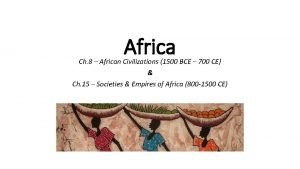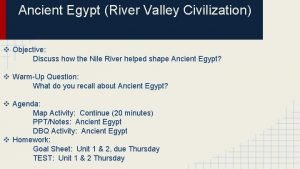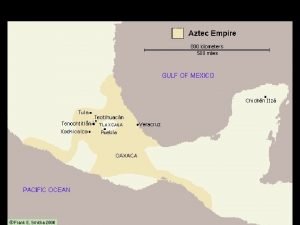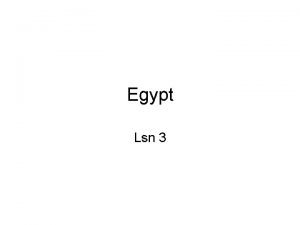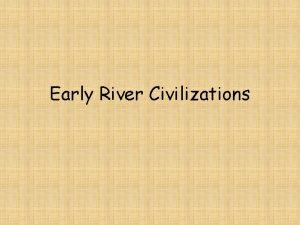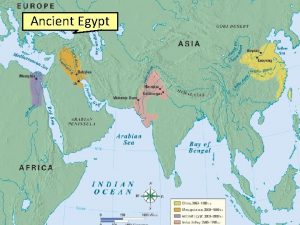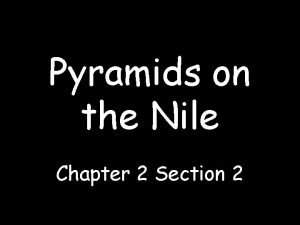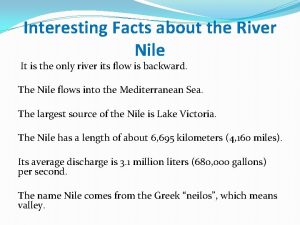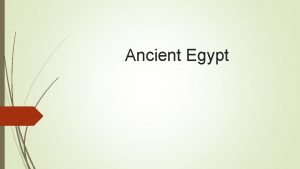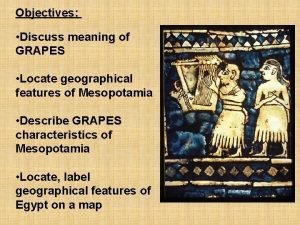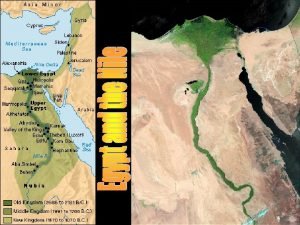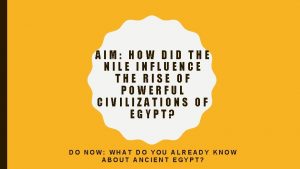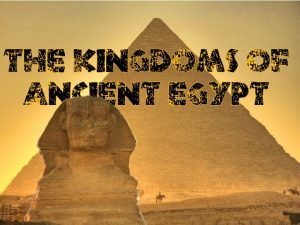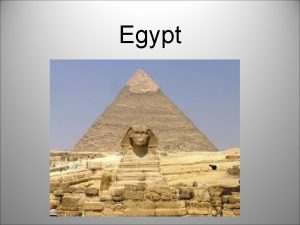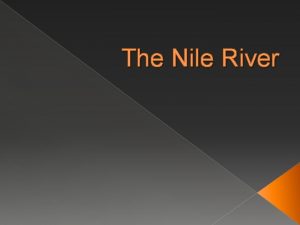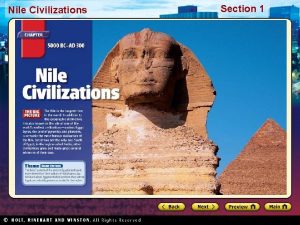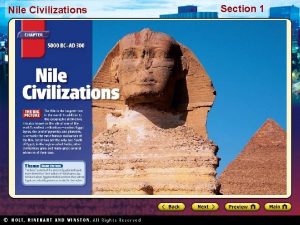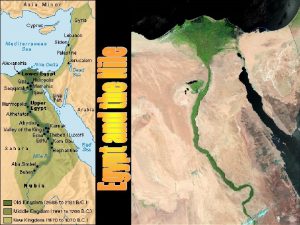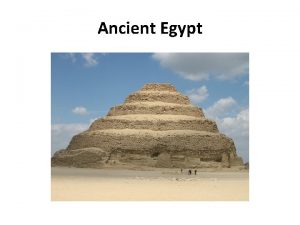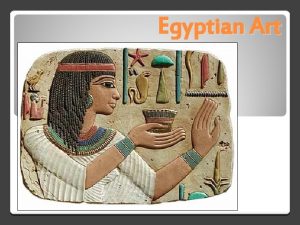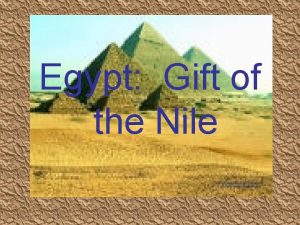Aim How did the Nile influence the rise




































- Slides: 36

+ Aim: How did the Nile influence the rise of the powerful civilizations of Egypt? Do Now: Geography Worksheet

+ Geography Vocabulary n. Cataract = waterfall n. Delta = triangular area of marshland formed by deposits of silt at the mouth of some rivers *Natural Barriers = less prone to invasion





+ Aim: How did religion and learning play important roles in ancient Egyptian civilization? Do Now: Review – How was the Nile River a blessing to the Egyptian civilization?


+ Egyptian Kingdoms n Old Kingdom: 2700 BCE-2200 BCE n Strong government n Middle Kingdom: 2050 BCE-1800 BCE n Turbulent Centuries n New Kingdom: 1550 BCE-1100 BCE n Height of Egyptian Civilization n Powerful Rulers: Queen Hatshepsut, Thutmose III, Ramses II

+ Egyptian Society Vocabulary n Dynasty – ruling family n Pharaohs – Egyptian kings, organized a strong, centralized state n Bureaucracy – a system of government that includes departments and levels of authority n Vizier – chief minister



(Slaves)


Mummification: Process of embalming & drying corpses to prevent them from decaying. Ancient Egyptians believed in an afterlife. They mummified the body so the soul could return later.

Anubis was the god who watched over the process of mummifying people when they died. After the embalming procedure, the mummy’s internal organs were placed in these clay Caponic jars.


As you know, the ancient Egyptians practiced a polytheistic, animistic religion. Here are some of the key gods of the Egyptian religion. Notice their animalistic qualities. Next to each god you will see their name, and what they are a god of.

Amon-Ra – the sun god. He was the most important god of the ancient Egyptians. Isis – the protective goddess. She used powerful magic to help people in need. Anubis – the god of embalming and the dead. Osiris – god of the dead, and ruler of the underworld.

Seth – the god of chaos. Atum – the creator god. Believed to be the first god to exist. Sekhmet – goddess of war. Horus – god of the sky. Protector of the pharaoh.

Hieroglyphics The earliest form of writing in Egypt were ideograms, like the one you see below. Each picture stood for an idea. For example a picture of a bird would mean bird.

As time past, the scribes needed to find an easier way of writing. As a result, a newer form of hieroglyphics was formed. Another innovation came overtime. Papyrus, a paper -like material was developed. Now scribes could write on a more compact surface, instead of stone or clay.

As the Egyptian civilization declined, any chance of deciphering hieroglyphics was lost…. … That is until the Rosetta Stone was discovered in 1799. The Rosetta Stone contained a message in 3 different languages: • Hieroglyphics (in a simpler form) • Greek Finally, in 1822 the stone was deciphered!!

+ Exit Slip: n You will be traveling back in time to the year 1400 BCE Ancient Egypt. You will arrive on the banks of the longest river in the world, the Nile. Most of Egypt is composed of desert and is hot and dry. Most of the people live near the Nile and depend on it for travel and many of the things they need in everyday life. n During your journey, you will complete a journal of your experiences. In your journal, you should include the following information: n Record a short description of the mummification process n Three interesting facts about the culture and civilization you encounter

+ AIM: Did Slaves build the Great Pyramid of Giza? Do Now: What accomplishments do you associate with the Egyptians?

What do you know about the Egyptian pyramids? 26

The Egyptian Pyramids

The Pyramids at Giza 28

How were the pyramids built? The Pyramids at Giza 29

Who built the pyramids? The Great Pyramid at Giza 30

The pyramids were built from LIMESTONE The Great Pyramid, built for Pharaoh Khufu, contains over 2 million limestone blocks, each weighing roughly 2 ½ tons! As the pyramids still stand today it is easy to see the ancient Egyptians knowledge in mathematics & geometry.

The diagram below shows the outside of the Great Pyramid. The pyramids in front of the Great Pyramid were built for the Pharaoh’s Queens. A temple was built in front of the Great Pyramid to allow daily rituals, and where offerings were left. The buildings surrounding the pyramid are called MASTABAS, MASTABAS which were tombs that held nobles.

The inside of the pyramid contained many different areas. • Air Shafts • King’s Chamber • Other Chambers • Grand Gallery • Queen’s Chamber • Underground Chamber

The Great Sphinx

The Great Sphinx is a large human -headed lion that was carved from a mound of natural rock. It is located in Giza where it guards the front of Khafra’s pyramid. Legends have been told for many years about the Great Sphinx. These stories tell about the powers & mysteries of the Sphinx. Some people believe that there are hidden passageways or rooms underneath, but nothing has been found…. yet!

Central Historical Question Did slaves build the Great Pyramid at Giza?
 What lasting legacies did the aksum kingdom leave
What lasting legacies did the aksum kingdom leave Tricky dick
Tricky dick Rise again and again until lambs
Rise again and again until lambs A union b example
A union b example Rise and rise until lambs become lions
Rise and rise until lambs become lions How did the nile shape ancient egypt essay
How did the nile shape ancient egypt essay How did the nile shape ancient egypt dbq answer key
How did the nile shape ancient egypt dbq answer key Why did new conservatism rise
Why did new conservatism rise How did hitler rise to power
How did hitler rise to power How did the rise of islam change the lives of women?
How did the rise of islam change the lives of women? What belief systems did this dynasty encourage? discourage?
What belief systems did this dynasty encourage? discourage? Rise of the aztec empire
Rise of the aztec empire How did vladimir lenin influence the russian revolution
How did vladimir lenin influence the russian revolution Seafaring traders
Seafaring traders King james and shakespeare relationship
King james and shakespeare relationship How did the spanish influence ranching in texas
How did the spanish influence ranching in texas The influence of neighboring cultures on japan
The influence of neighboring cultures on japan Yellow journalism style
Yellow journalism style Lego shaduf
Lego shaduf Nile chemicals
Nile chemicals Absolute and relative direction
Absolute and relative direction River valley civilizations map
River valley civilizations map Nile river
Nile river Pyramids on the nile chapter 2 section 2
Pyramids on the nile chapter 2 section 2 Green river killer map
Green river killer map 5 facts about the river nile
5 facts about the river nile Nile floodplain
Nile floodplain Wheres the nile river
Wheres the nile river A section of the nile river with rapids and rocky terrain
A section of the nile river with rapids and rocky terrain Northampton library login
Northampton library login Infinitive nile
Infinitive nile Frontalism in egyptian art
Frontalism in egyptian art Ancient egypt advanced cities
Ancient egypt advanced cities Nile river clipart
Nile river clipart Kush nile river
Kush nile river Nile floodplain
Nile floodplain What does the picture tell us
What does the picture tell us
